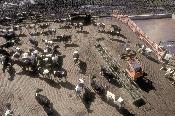January 2012 Volume 21 - Number 10
States submit draft strategies to clean water
A year after the EPA put the Bay on a "pollution diet," states are providing new details about how they - and local governments - will curb the nutrient binge that transformed the Bay's once-clear water into a murky soup over the last 50 years.
States in mid-December began turning in first drafts of new Phase II Watershed Implementation Plans - or WIPS - that will guide cleanup efforts through 2017 and ultimately affect nearly all of the 16-million-plus residents of the Bay watershed, from how much they pay in sewage bills and stormwater fees to how farmers apply manure and fertilizer to their fields.
The WIPs spell out the programs that will lead to a healthier Bay with clearer water filled with lush underwater grass beds instead of algae-stained water filled with oxygen-starved dead zones.
[
Full Story].

Sea level along Chesapeake rising faster than efforts to mitigate it: Imagine living in a neighborhood where people check the tide gauges to figure out where they should park their cars. A place where front yards sprout wetland plants and smell like marsh grass, where city leaders debate spending millions of dollars to raise yet another street, and where prospective homeowners consult computerized flood maps to determine if it's safe to buy a house.
Large-scale SAV restoration discouraged until water quality improves: A scientific review has offered advice about trying to plant large-scale underwater grass beds in the Chesapeake: Don't bother. At least not until the Bay's often-murky water gets clearer.
EPA report links groundwater contamination to natural gas drilling: The EPA has issued a draft report confirming what many environmental groups have long suspected: Natural gas drilling is causing groundwater contamination.
Economist asks: We are growing, but are we more prosperous?: Imagine a thrillingly powerful sports car whose speedometer dominates the dash, obscuring gauges that warn of fuel guzzling, overheating, needed maintenance and pollution. Not to worry! If you run into any problems, just keep pushing on the accelerator, the car's designer says.
Support for offshore wind power picks up speed in Bay states: Travelers across the 20-mile Chesapeake Bay Bridge Tunnel that connects Virginia's rural Eastern Shore with the urban center of Norfolk and Virginia Beach have an expansive view of the Chesapeake Bay - a view often heralded for its breadth and beauty.
Dam demolition now the preferred method for creating fish passages: Bay states removed 11 dams in the Chesapeake watershed during the past year, opening 148 miles of river habitat to migratory fish, according to figures compiled by the Bay Program.
Delmarva litter storage suit ruffles feathers throughout the poultry industry: When a federal judge hears arguments in the so-called "chicken lawsuit" this April, it won't be just the chicken growers who will be paying attention.
Waterkeeper attorneys join consumer group, Food & Water Watch: Two key players in the Chesapeake Bay's Riverkeeper movement have left the organization to start a legal advocacy project that will focus on industrial agriculture and natural gas drilling.
New policies contribute to VA's surge in land conservation easements: In 1958, Andrew Packett's parents bought a farm on the Northern Neck of Virginia. The decision defined the rest of their lives, and their son's life, too.
Plan to make Baltimore Harbor swimmable, fishable by 2020 unveiled: Business leaders, neighborhood activists and schoolchildren recently joined Baltimore Mayor Stephanie Rawlings-Blake in unveiling a plan to clean up Baltimore's Inner Harbor.
